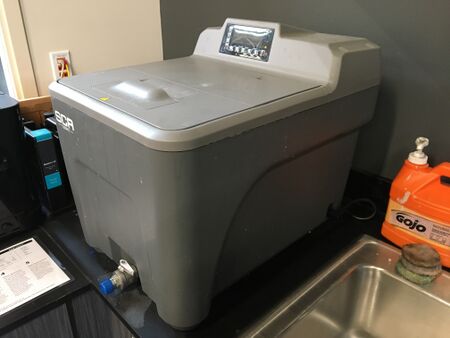Dissolvable Support Bath
Revision as of 14:36, 6 February 2019 by Jwhipple15 (talk | contribs)
The Dissolvable Support Bath is used in conjunction with both Stratasys 3D printers, the Dimension and the F370. Since these printers use QRS support material, the support can be dissolved in a heated, agitated, diluted solution of Sodium Hydroxide.
Sodium Hydroxide can be dangerous when handled incorrectly, therefore there are various safety procedures associated with the use of the Dissolvable Support Bath.
The Dissolvable Support Bath Ace is <ul><li>The part "Dissolvable Support Bath" of the query was not understood.Results might not be as expected.</li> <!--br--><li>Some subquery has no valid condition.</li></ul>.
Safety Procedures
- Only Prototype Lab Mentors are allowed to use the Bath for safety concerns
- Required safety attire is a lab coat, safety goggles, and heat/chemical protecting gloves
- Only the Ace of the Bath and the Aces of the Prototype Lab (and Justin) are allowed to drain the tank and replenish it with a new solution of diluted Sodium Hydroxide
- Wash your hands after using the bath and after touching parts that have been removed from the bath within the past 24 hours
- All parts that come out of the bath should be washed and left to dry/drain excess fluid for at least an hour
- All spills should be immediately reported to Justin and the Aces of the Prototype Lab
- Follow the MSDS procedure in the event of getting Sodium Hydroxide on your skin, in your eyes, or if you ingest it
MSDS Knowledge (soon to be switched to SDS)
- The MSDS is located next to the sink in a bright yellow binder hanging on the wall
- It includes the fluids the Prototype Lab uses that could be dangerous when humans are exposed to it, and it details what to do if the fluid is ingested, gets in your eyes or on your skin, and other pertinent information.
Mentors Only
- How to use bath:
- ALWAYS USE SAFETY ATTIRE.
- Flip the black switch (inside the yellow rectangle) to turn the bath on
- Then press the button circled in red to start the heating process
- The red knob (circled in cyan) should always be set to 70 degrees Celsius
- Keep the lid shut as often as possible
- Place the part inside of a mesh bag, tie the strings of the mesh bag to the side handles, allow the part to soak in the bath for several hours
- Mesh bags are located in the small drawer next to the sink
- When removing parts:
- If needed, the basket can be lifted out and removed so that parts can be sifted through in the air instead of the solution. If you do remove basket, removed the lid first and place it in the sink. Next, lift the basket, let it drain above the bath so that it drips into the bath, then once it is barley dripping, the basket can be transferred to the sink.
- Wash the mesh bag and part thoroughly. Use paper towels to dry the part and let the part sit on paper towels and drain for a couple hours. Always inform the part's creator to wash their hands after handling the part and before eating or touching their eyes/face.
- Replace the basket and lid.
- ALWAYS USE SAFETY ATTIRE.
- What to do if the bath is beeping:
- This means the bath is low on water (below 1.5 horizontal holes of the basket inside)
- Take the clear bucket under the sink and use it to fill the bath until the fluid level inside is only 1.5 horizontal basket holes from the top
- Tell Ben, Gabi, or Justin if you think the solution should be switched, do not do it yourself
- What to do if the bath appears to be leaking:
- Immediately inform the Aces of the Lab and/or Justin
- This would mean there is a collection of water inside of the grey catch tray underneath the bath.
- What to do in the event of a spill:
- Evacuate the lab and shut it down until the spill has been properly cleaned
- Immediately inform the Aces of the Lab and/or Justin; if unavailable and the spill is large then contact Security
- Use the spill kit
- There should be instructions inside
- Make sure you are wearing safety attire
- How to use bath:
For Prototype Lab Aces and Bath Ace Only
- How to change the solution in the bath:
- Wear safety attire during the entire process
- Retrieve a barrel to drain the fluid into
- Unscrew the top of drain spout (make sure the drain spout is completely pushed in before unscrewing)
- Swivel the drain spout to face down
- Align the barrel opening to be underneath the drain spout
- Pull the drain spout out so that the fluid begins to drain
- Completely drain all of the fluid
- Clean the inside of the tank
- Use water to rinse out the inside of the tank then use paper towels to wipe out the gunk
- Be sure to also clean the basket thoroughly
- Replace the basket
- Fill the bath up with water (use the clear bucket under the sink, fill this with water from the sink, pour the water into the bath) until the water level reaches 1.5 horizontal basket holes from the top
- Turn the bath on and have it heat up to 70 degrees Celsius
- Take a pre-filled bottle of Sodium Hydroxide (located in the thin cabinet underneath the counter the bath sits on) and sprinkle some into the heated water
- Allow the sprinkled amount to dissolve and repeat until all of the Sodium Hydroxide in the bottle has been dissolved in the bath
- Refill the Sodium Hydroxide bottle if there is only one filled bottle left
- How to fill new Sodium Hydroxide bottles:
- Wear a lab coat, nitrile gloves, and safety goggles. This is very important. The granule Sodium Hydroxide (undiluted--undissolved) is much more dangerous.
- There should be a mini funnel in the lab somewhere (it tends to move around some). Use the large Sodium Hydroxide bottle and mini funnel to refill the small bottles up to where the level in the last remaining bottle is. Always leave one bottle filled as a gauge for where to refill to. If a bottle has not been left filled, then fill the small bottle to about 1.5 inches below where the narrowing of the bottle begins.
- When to change the solution in the bath:
- This is not an exact science. Before the F370, all dissolvable support material was a translucent black. This meant that the bath would become a milky brown when it needed to be changed. Now the F370 introduces an opaque white material which causes the bath solution to continuously appear milky which creates confusion when trying to figure out when to change the solution.
- As of right now, we recommend making a best guess. When the bath starts taking a very long time to dissolve support material, it is probably time to change the bath.
- Some thoughts for changing this in the future:
- Use the Job Log's ability to track the support material dissolved in the bath and develop a number for when the bath needs to be changed. Then set the Job Log up to alert the Lab when it has reached that number.
- Attempt to obtain translucent black support material for the F370.
- Attempt to use a chemical strength measurement to determine how strong the solution in the bath is and determine a checkpoint strength for when to switch the solution.
- How to change the solution in the bath:

